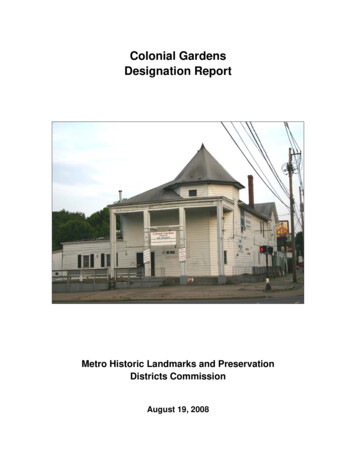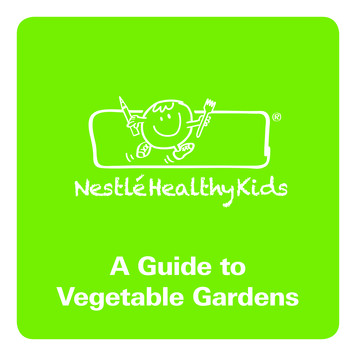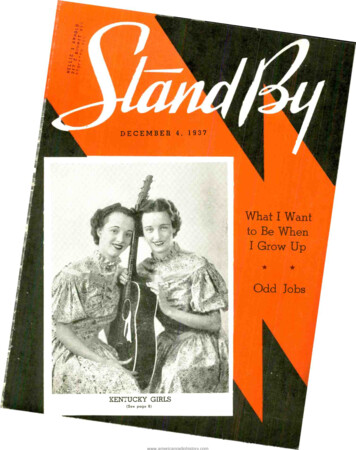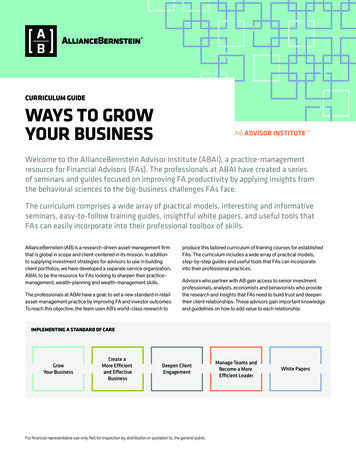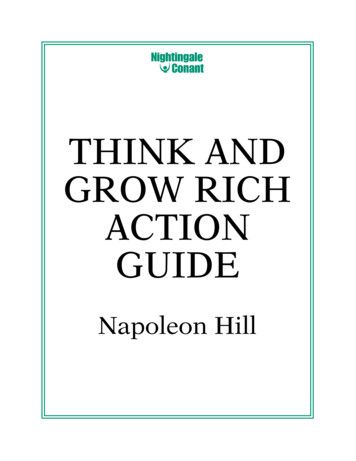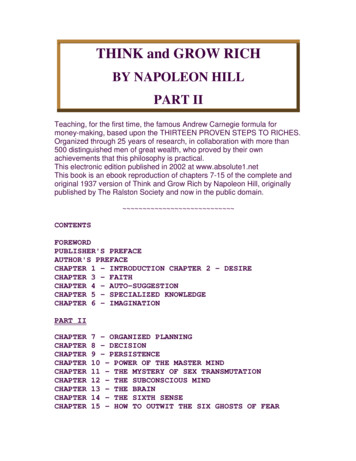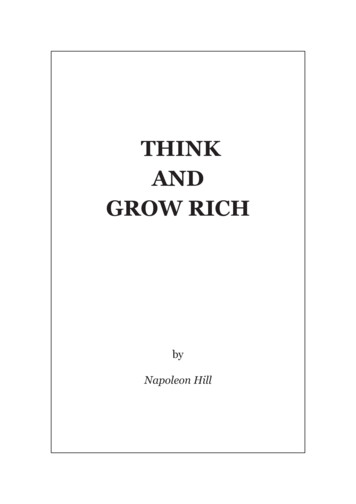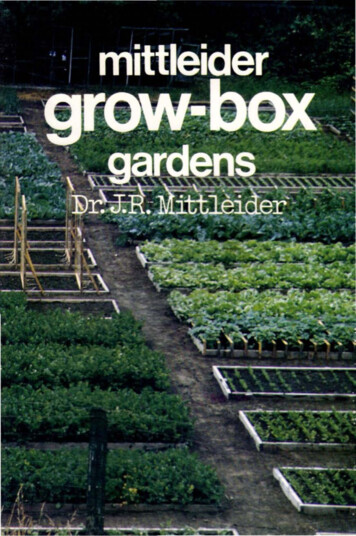
Transcription
Mittleider Grow-Box GardensBy Jacob R. MittleiderAdjustments & Improvements Since PublicationPage #Original BookRecommended Changes33.Grow-Boxes 5’ wide . . .Now recommend 18” or 4’ wide Grow-Boxes.38.Aisles of 3’ . . .Aisles of 3 ½’ recommended for 18” Grow-Boxes4’ aisles are recommended for 4’-wide Grow-Boxes38.1” X 8” redwood or cedar wood . . . Treated 2” X 8” pine recommendedRedwood or cedar stakes . . .Pine stakes – preferably 2” X 2” and painted preferred.41.12” 1” X 8” or Stake for splicingEnd pieces – 5’ long 1” X 8”Treated 12” 2” X 8” is recommended for splicing.Use 2” X 8” treated lumber – 18” or 4’.43.Spreader board – 2” X 4” X 6’Use 5’ length for 4’-wide box or 2’ length for 18” box.46.Sawdust – from almost any woodAvoid walnut sawdust, which is toxic to many plants.47.Spread 10# lime on ground . . .Apply Pre-Plant onlyIn 18” box apply 1 oz/ft – in 4’ box apply 2 oz/ft.48.Pre-Plant formula . . .Apply 12# 2 oz to soilApply 5# lime to soilWeekly Feed – nothing saidPre-Plant - calcium, magnesium, & boron – 80-4-1 ratio.In 18” box apply 1 oz/ft – in 4’ box apply 2 oz/ft.None, only Pre-Plant above.Apply ½ oz/ft in 18” box – apply 1 oz/ft in 4’ boxSee Weekly Feed formula in Mittleider Gardening Course53.Dates for planting common cropsSupplement with Garden Planting Details schedule, and useYour ADLF (average date of last frost) for planting dates.54.Sample Planting LayoutThere is real merit in this, because short rows of manycrops can be ideal for family gardens. However watering,fertilizing, and difficult access to the center of the bedconvinced Dr. Mittleider that 4’ wide and planting lengthwise is generally a better solution for the home gardener.Apply both Pre-Plant (1 oz/ft) and Weekly Feed (1/2 oz/ft)mix with the soil, and plant another crop if time allows.After a crop is harvested . . .55.A marker for uniform plant spacing Use an 8’-long 2” X 2” board, with dowels 6” apart on oneside and 7” apart on the opposite side.56.List of plants and spacing.Recommend using Garden Planting Details schedule ifgrowing lengthwise in 18” or 4’ boxes.64.Transplanting SolutionImmediately after transplanting apply ¼ oz/ft of nitrogenfertilizer down the center of the row and water in.
68.“Plants can be watered with a . . “Automating the watering is recommended. See MittleiderGardening Course Lesson 16.“One or two . . watering per week” Do not let your plants begin to wilt! Water daily if needed.69.“Nearly 95% of a plant’s weight . “ Water constitutes about 80% of a plant’s total weight. Asmuch as 95% of the water entering a plant on a hot daypasses through as transpiration, to keep the plant cool.71.Mittleider Nutrient Formula72.Optional Nutrient FormulaThis formula works short-term in many soil-bed gardensGrow-Box gardens need the complete nutrient mix.73.Very ImportantEliminate paragraphs 13, 14, and 15.75.How to support tall plantsSee Mittleider Gardening Course Lesson 15, and theHow to Build and Use T-Frames schedule. Use a single Tframe with 6’ top for 4’-wide boxes placed in middle.76-86.Guiding, pruning, & tyingExcellent material and highly recommended.97-108.Making a simple greenhouseRecommend – Constructing a Greenhouse – Appendix Dof The Mittleider Gardening Course book. Any greenhouseshould have sides that roll up for ventilation, and if largerthan 10’ wide a continuous ventilator at the top is importantFertilizer formula in Mittleider Gardening Course Lesson 5is recommended, or purchase Micro-Nutrients from FFEFwebsite www.growfood.com and mix as instructed.Feed 1# 4 oz for 5 X 30 BoxApply ½ oz/ft WF down the center between 2 plant rows.Stop feeding 2 weeks before harvest Stop feeding 3 weeks before harvest for single-crop plants.Stop feeding 8 weeks before hard frost for ever-bearing.Soil-beds or Grow-Boxes should be 18” wide, and aislesshould be 4’ wide. Therefore, 12’ 6” of width is minimumneeded for 3 soil-beds or Grow-Boxes.109-110.Filling Grow-Boxes in Greenhouse Use Pre-Plant Mix – 1 oz/ft in 18” & 2 oz/ft in 4’ boxes.111.“Now add the Pre-Plant fertilizer . . Use Pre-Plant formula of calcium, magnesium, and boronIn the ratio of 80-4-1. Apply 1 oz/ft in 18” box & 2 oz/ftIn 4’ box. Apply Weekly Feed at ½ oz/ft in 18” box & 1Oz/ft in 4’ box.D. & NoteLime or gypsum is not needed in addition to Pre-Plant Mix.“Plants in the greenhouse are fed a The same amount of fertilizer is used whether plants are inlarger amount of fertilizer.”The greenhouse or outside in the garden – and whether inthe soil-beds or Grow-Boxes.112.114.Preparing your nutrient mixtureSee pages 71 & 72.“From the time seeds are sprouted. . . Weekly Feed is applied ½ oz/ft in 18” beds or boxes, andthey are fed . . .”1 oz/ft in 4’ beds or boxes.115.“After flowering begins . . . to endContinue feeding the same amounts of Weekly Feed until
3 weeks before harvest for single-crop varieties, and until8 weeks before the first hard frost for ever-bearing plants.116.“Plants appear to be nutrient hungry Increase the feedings to twice per week for two weeks.116-117.For training vining and climbing . . Recommend 1 row of plants per bed or box, with alternatePlants going up baling-twine strings to 2 rows of wire, pipe,or 2 X 4’s on edge 28” apart. “Aisle” space at the top is33” in the two aisles.The bottom end of the string . . .Is tied to tie-wire placed at the base of the plants. The tiewire is attached at both ends of the Grow-Box and tostakes at maximum intervals of 10’ the length of the box.121.Watering in the greenhouse . . .Watering Grow-Boxes should be daily in greenhouse &garden.123.Mild climate greenhouse plasticUse UV-protected 6 mil greenhouse plastic for all climates.135.Starting seedlings for transplanting Tomatoes and peppers take 8 weeks from seed to transplant-size plants, so growing these in a protected environment can save you that much time. Large-seeded plantslike beans or squash take much less time to grow totransplant size, so you will be saving only 3 to 4 weeks.Bottoms can be made with 3 slatsUsing 5 or 6 narrower slats to cover the bottom is better.136.Spread ½ oz lime & ½ oz 0-45-0Spread 1 ½ oz (3 TBSP) Pre-Plant Mix and mix into soil.137.Seeds per row in 18” X 18” flatCelery & parsley should be 100-125 /row. Large seedsSuch as beans, squash, etc. should be 25-30/row.138.Every watering after seeds sproutWhen sprouts first appear begin watering with “ConstantFeed solution – 1 oz Weekly Feed in 3 gallons of water.The first transplant should be into 2” or larger pots, orInto other flats, 49 to 81 per flat, depending on plant size.Seedlings are transplanted to . .140-141.If flats have been used before . .Methyl Bromide is very difficult to obtain, is veryexpensive, and can be deadly. A Pesticide Applicator’slicense is required to handle it. Therefore other methodsof sterilizing your flats should be pursued. Bleach andwater (1 to 10), or vinegar and water (1 to 2) can be used.145.Common soil us usually more work Many years’ experience in soils all around the world taughtand somewhat less rewarding than Dr. Mittleider that growing in the soil was just as productGrow-Boxes or greenhouses.ive as Grow-Boxes & greenhouses. See 6 Steps to Successful gardening, Grow-Bed Gardening, and The MittleiderGardening Course books for greatest success in the soil.146-153Open furrow soil-bed gardeningNumerous material changes and improvements have beendiscovered and perfected since this book was written.Raised level 18’-wide beds with ridges are a big factor inmaking soil-bed gardening at least the equal of Grow-Box
gardening. The books named above are highly.Recommended.For field crops 3 applications of Weekly Feed are normal –1 before planting and 2 after – at 3-4 week intervals.170.Questions often asked:Why use redwood or cedarShould Grow-Boxes face N/SNow that treated 2 X 8 lumber is readily available and safeto use, that is preferred over redwood or cedar.Not necessary. What IS important is that tall plants begrown North or East of shorter plants, so as not to shadethem.Sizes of Grow-Boxes have changed, fertilizer formulashave changed, and application rates have changed. Readprevious comments and review topics in The MittleiderGardening Course book.173.Appendix II183.Appendix IIIA much more comprehensive schedule of nutrientdeficiencies and corrective treatments is attached hereto.187.Appendix IVFor materials list to build recommended greenhouse seeAppendix D of The Mittleider Gardening Course book.192.Appendix VWhile numbers, sizes, and configurations are no longervalid, multiplied thousands of families around the worldhave proven the validity of the assertions made herein.
mittIeidergrow-boxgcwdensDr. .IR llitt1.eid.er
mittleidergrow-boxgardensBYJACOB R. MITTLEIDER, LLD.AGRICULTURAL CONSULTANTLECTURER, LOMA LINDA UNIVERSITYILLUSTRATED BYDON BERGGRENInbUnationCll Food PtOCIuction mczthocl).lnc.Salt Lake City, Utah
Published and Distributed byInternational Food Production Methods, Inc.Post Office Box 17114Salt Lake City. Utah 84117Copyright 1975 by Jacob R. Mittleider, under the title "More Food From YourGarden."This edition printed by arrangements with Woodbridge Press Publishing Company,California 93111.All rights reserved. This book or any part thereof must not be reproduced in any formwhatsoever. whether by graphic. visual. electronic, or any other means; or be translatedinto any language, devices, or symbols. without the written permission of InternationalFood Production Mettlods. Inc.Post Office Box 17114. Satt Lake City. Utah 84117.Library of Congress Catak g Card Number: 78-52953Printed in the United States of America
DThis book is dedicated to my family Mildred Mittleider, patient and supportive wife, tolerant and braveamid the frustration and uncertainty of life with an adventuroushusband. Without her, success would not have been possible.Douglas and Carol Deitrich, son-in-law and daughter, whoencouraged me in the development of the first experimental modelsthat stimulated this entire program; and who still inspire towardcontinuing refinement and perfecting.Dr. James R. and Jeannie Wise, son-in-law and daughter, whoalso built and planted the early model gardens whose success wasconvincing evidence that millions could benefit from theseextraordinarily productive techniques - if only they had theinformation.To these, and others, who encouraged and motivated me toaccomplish that in which I really believed, I gratefully dedicate thisbook.-The Author
I wish to thank Edmond Henken, my chief associate, for his encouragement.loyalty, hard work, advice, and support through both prosperousand adverse times. In my estimation, he is the one person who hasgained the most complete knowledge of my entire concept andmethod as outlined in this book. He has not only the theory but alsothe practical experience to conduct the program and also toadvance it.Willis J. Hackett, for his confidence and encouragement, for hisbelief in the methodology, and for the foreword he generously wrotefor this book and for a previous book.Lynn Galr, M.D., for loyalty and personal involvement in pastyears. helping to bring this program to success. Without his helpthere would never have been the opportunity to develop it, eitherabroad or in the United States.D. L. Stoops, M.D., whose humanitarian nature led him to studythe Mittleider program thoroughly as a means of helping hungrypeoples, and then to promote it and encourage its development.Don Berggren, the illustrator of this book. Without his outstandingtalent it would not have been possible to prepare this work formankind. It is a rare privi lege to work with so talented a person whois also selfless and sensitive to human need.-The Author
FORE.WORD. . . . . . . . . . . . . . . .IIINTMDUCTION . . . . . . 13a".WHAT 15 TH M1TTL.e.IDE.R. METHOD?.Z"! . GARVE.N GPDW -OOXE.'S . . . '"2 3 HOW TO MAf .C. oFOW-eoXE.'S 1 USING "CUSTOM-MADE. 'SOIL"4S PLANNING YOUR@PLANTING YOUR G N GROW·eoX. 5777WATERING AND FE.E.OINGYOUR PLANTS. /&.1 DE.N LAYOUT. 51 . . HEL.PING PLANTS Gf .OW . . . 75rtJ . GRE.ENHOUSE. - SHE.L.TE/ .E.DGf OW- e,oXE.S!lV. MAKlNGenA SIMPL.E0RE-EN HOUSE. . . . . . . . . . . . . . . . "17OD. succesSFuLG HOU5E GARDENING/O'l
uf6COL'DWEATHER. E.NING . . . 11.3n STARTING 5E.E.OLlNG5 FORTRANSPLANTING . . . . . " . 135 .THE. MITTLE.IDER METHOD IN143OPEN FURROWD gTHE HARVE.'5T:lQJJESTIONS OFTEN "''5I .E.DISS110.!§S . MITTLEIDERFERTII.-I"l.E.R FOf ,MULA'5 . . . 11 .PLANT NUTRIENTDE.F/CIENCI E'5183m. iVlATE.RIAI.-SLiSTS FORGr DW- eoXE.S ANDGREEN HOU6E., 1f'1 . COMME.RCIAI.- APPLICATIONSOF THE. MITTL.E.IDER METHOD. 1'12
Three decades of almost constant study and research on foodproduction problems in many parts of the world have long sinceconvinced me that the most prom ising approach is a synthesis olthebest features of several major methods of gardening.Organic gardening emphasizes plant access to all available soilnutrients and microbial activity; conventional gardeningemphasizes adequate fertilization and pest control; hydroponicgardening emphasizes high-density planting in a controlledenvironment.But each of these methods, alone, has some limitations.What I have been demonstrating in various countries isa bringingtogether of the best scientific knowledge and experience in each oflhese approaches. I believe that the results speak for themselves.This book is a step-by-step guidebook to the use of my methodsby the home gardener. If you have a rewarding gardeningexperience and it is due in part to the instructions given here, I shallbe amply rewarded for the effort involved.I would encourage the serious student of gardening to obtain acopy of a previous book, coauthored with Dr. Andrew N. Nelson, agifted man whom I greatly admire. Its title is Food for Everyone and itmay be obtained through the publisher of this book.-The Author
Abundant food now flourishing on once arid an
Mittleider Nutrient Formula Fertilizer formula in Mittleider Gardening Course Lesson 5 . is recommended, or purchase Micro-Nutrients from FFEF . website . www.growfood.com and mix as instructed. Feed 1# 4 oz for 5 X 30 Box Apply ½ oz/ft WF down the center between 2 plant rows. Stop feeding 2 weeks before harvest Stop feeding 3 weeks before harvest for single-crop plants. Stop
